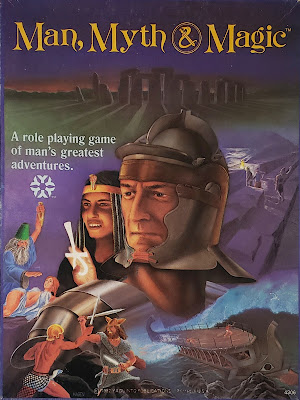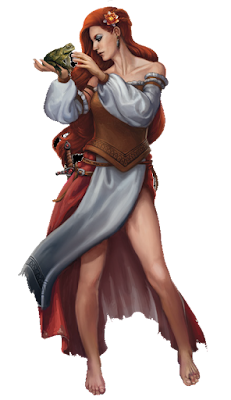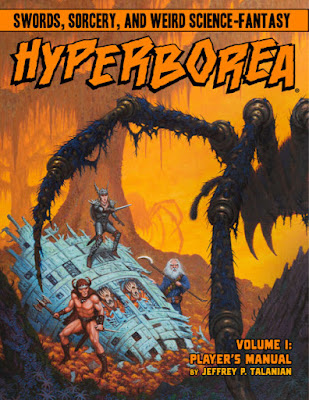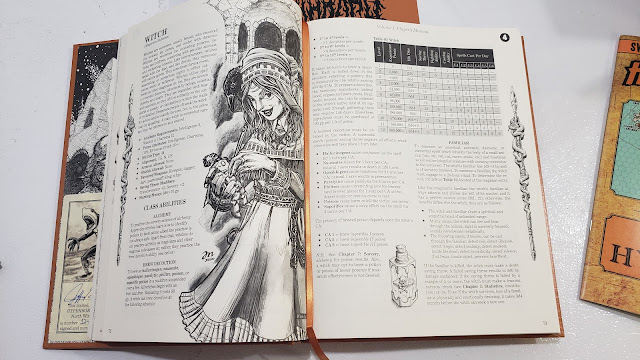I will be honest. Of all the Realms products out there, this one feels like the hardest to review properly. But I will carry on.
Forgotten Realms Campaign Setting Revised
1993. by Ed Greenwood, Jeff Grubb, and Don Bingle. Art Clyde Caldwell (book covers), Fred Fields (box cover), Interior art by George Barr, Dennis Beauvais, Tim Conrad, James Crabtree, Eric Hotz, Robin Raab, Uttam, and Valerie Valusek.
NOTE: For this review I am considering both my original* boxed set and the PDFs** from DriveThruRPG.
Ok, there is a note on my note. First, I got my boxed set in a game auction. So I know for a fact there is extra material in my box. I have a second set of maps that look different from the other set. I am not entirely sure which set belongs. This is the problem when buying collections, going to auctions, and inheriting other collections. There is a lot more in this box. SO, I bought the PDFs for this review. I figure I might as well (I didn't have them) AND the PDF version has a different cover. Now I had that boxed set for a bit, but it was beat to all hell. I didn't know which one came first. So I kept the best looking box and best books. Likely, that is why I have extra stuff.
I learned that the "gold" cover box that had the same art as the 1st Edition set was the first, and the one I have was the second printing/version. Either way, the interior contents are the same.
Except mine that is. Mine is special. ;)
Ok, all that aside, let's jump into this bit of D&D history. The box set has three soft-cover books that I'll take in turn.
A Grand Tour of the Realms
This 128-page softcover book is the player-facing book for this set.
I think the biggest surprise for me was that this is where (at least for me) the Relams absorbed the campaign settings of Kara-Tur (previously part of Greyhawk at least in practice), Maztica, and Zakhara. Now of all these Zakhara was the most interesting to me and I flirted with buying the campaign setting a few times in the early 90s. But I was still an undergrad and there was always another Ravenloft book. Each setting gets a little overview here.
Likewise, the various peoples of the Realms are mentioned. Humans predominate, but dragons, dwaves, elves, goblins, gnomes, and more also get a mention here. The standard D&D species/races are here. Indeed, here is where many learned of these races for the first time in conjunction with AD&D 2nd edition rules.
Up next, the standard classes are covered here. It's 2nd edition now, so Bards are not relegated to the back of the book. I would argue that is was 2nd Ed Realms where Bards got their proper due.
Our next large section is all about Faerûn. This is the continent that people think of as synonymous with "the Forgotten Realms." The larger sections of the continent are covered briefly here. This is helpful for me since I never really know what people mean when they say "The North" for example. The map following this is even better. The large poster maps are great, but unwieldly to be honest.
Some print is given over to the months and years, which I love. In the two Realms campaigns going on here in my house (my "Into the Forgotten Realms" and my oldest kid's "It's Always Sunny in Waterdeep") I have gotten fairly used to thinking of times in Dale Reckoning. The current year for this set is 1368 DR.
Languages are next. It is really fun to see the Dethek writing here after seeing it the Baldur's Gate 3 video game.
Up next are more detailed descriptions of various locales. The Dales and the Elven Courts, Cormyr, Sembia, The Moonsea, The Vast, The Dragon Coast, The Western Heartlands (including the Sword Coast), Waterdeep, and beyond (Evermeet, Moonshaes, etc.). Each gets a few pages to discuss important sites and people. There are adventure seeds galore.
There is a lot here, but not a lot of details on any one thing. This is actually good in my mind. It gives me room to work (I know... remarkably naïve on my part), but it did give some ideas for the next adventure I am going to run.
The back cover has a list of the Forgotten Realms Adventure Backlist with prices up to that point. Still impressive by 1993, to be honest. I know I am missing a lot of these, but my Forgotten Realms buying is limited (on purpose) to what I can find via my local game auctions or Half-Price Books or other used sources.
Running the Realms
This is our DM's book. It's 64 pages and features one of my favorite Clyde Caldwell pieces ever. I have a signed print in my game room. An aside. There is something about the size of the TSR-era 64 page books. Hits my nostalgia for the BX books.
Here we get a good and proper introduction to the Realms. The voices of Jeff Grubb and Ed Greenwood ring out loud here in their respective introductions. And we learn this is the 3rd Age of the Realms.
We start the book proper with a Campaigns for New Players. I am neither a new player nor unfamiliar with the Realms, but I found this to be a good read with some great advice. Some of this reads very similar to the 1st Edition Gray box. This falls under the "if it's not broke, don't fix it" rule.
Wild Magic and Dead Magic zones are discussed. I am not sure how much I would have used these back then, but I am going to make an effort to use them more now.
There is a great timeline from -2637 DR to 1368 DR. I am still in 1357 DR in my games.
After this, some News of Realms covering recent local events follows. It reads like a set of newspaper articles.
There is a section on the Secret Power Groups. The Harpers, the Cult of the Dragon, and the like. I have learned to use these sparingly. The Cult of the Dragon can be huge and my players would want to hunt it down and take them out for good. And the Harpers can swoop in and steal all the glory. Now other groups like the Red Wizards and Zhentarim are still great to use. Likewise, there is a roster of Select NPCs. The usual suspects are here. Again, this is a season to use sparingly. BUT it is nice to have these here. It is also nice to have a picture and pronunciation guide for some of these names. Because seriously Ed? What the hell?
There is a section on Gods that is good, but will see expanded in the next few years. Gods are ever changing bunch in the realms. The names stay roughly the same, but powers and portfolios can vary. It is always fun to read these starting with Ed's Down to Earth Divinity from Dragon Magazine.
There is some "player" information here, but I feel the idea here is that DM will parse that out as they feel necessary.
The back cover has Forgotten Realms novels published to date.
The Fogotten Realms novels are like cheeseburgers. Some are great and really fill you up. Others are the fast food variety; great when that is what you want and often cheap and easy to get. Others are sliders. They seemed like a good idea at the time, but when you are done you are questioning your choices. Now I have not read a lot of these to be fair, and really I should not judge; I read all the Ravenloft novels.
Shadowdale
This 96-page softcover book is part location guide, part base of operations, and part adventure.
Reading through this now I am reminded of how important the Dalelands used to be in the Forgotten Realms. It was *the* place to adventure back then. Back then I wasn't sure if it was from the novels or that's where Elminster had set up shop. I think now it must have been largely due to this book. I could be wrong, it's hard to judge cultural phenomena (and that is what is was in online D&D discourse) 30+ years later.
But, I am not here to judge this on past or perceived merits of the past. I am looking at the text in front of me.
This book is broken up into sections detailing the history of Shadowdale and the lands including the farm lands around it (aside: growing up in the Midwest I don't think enough people understand how important farms were/are and how much land they can take up. Thankfully most of the AD&D guys are of the same background as I am.)
We also delve into the Village of Shadowdale, places of interest, and the temples. These include, respectively, Elminster's Tower (which should be a tourist location by now) and the Temple of Mystra.
About half this book is given over to the adventure "Beneath the Twisted Tower." Which was briefly profiled in places of interest. It is an adventure for parties of 1st to 3rd level and set after the Time of Troubles. The tone shifts here and I wonder if this was the contribution of Don Bingle. To continue my BX D&D association, this would be the Caves of Chaos to Shadowdale's Keep on the Borderlands.
This book has the most "new" information to me. There is a huge underground cave system here with a lot of potential. The best part is that it gives new players a solid taste of what is in the realms. It's like a charcuterie board of Realms favorites, served in easy-to-eat sizes. The areas of Wild and Dead magics are also clearly marked, so that is fun. I gotta remember to use those more when the time is right.
Another Aside: I need to look into how and why Wild and Dead magic began here. Was it a side-effect of the Time of Troubles or did it happen before? I thought it was a side effect, but maybe I am wrong.
The adventure looks fun, but reading it is not playing it. If my party gets to the Dales I might give it a try. The one thing I don't lack is low-level adventures in the Realms.
The book ends with a comprehensive Index of all three books. It is easy then to see what entries get coverage in which books, sometimes multiple coverage.
Other Materials
I mentioned before that my boxed set seems to have materials from other sets and I have not identified which is which.
There are the four large poster maps of Faerûn (I have two different sets), and the clear hex maps to place over them. This was a great idea. While I loved the maps from the D&D Basic and Expert sets, they always looked like they were drawn to fit the hexes. These are maps and the hexes come later.
There are full color card-stock inserts of various symbols, sigils, and signs from the Realms which is great to show players what they are looking at.
And much to my pleasure AD&D 2nd Ed Monstrous Compendium inserts. My Forgotten Realms MC binder is getting quite full now.
DriveThruRPG PDFs
The PDF/Zip file from DriveThruRPG has all three books plus the Monstrous Compendium pages in one large, 312 pages, file.
The text is sharp and the tables of contents are hyperlinked. The index in not. The images are bit dark, but not so much so that they are hard to make out. I should note that some of the images are also dark in my boxed set, so that could just be how they came out in the color to black-and-white conversions.
I did print out the Monstrous Compendium pages so I could keep the originals in the box set intact and for better alphabetical sorting.
The zip file contains JPGs of all the inserts, including the acetate hex map overlays (why??), front and back of all the cards (which is good, now I don't have to cut up the ones in my boxes), the maps, and the poster that came with it. Wait a minute! My boxed set doesn't have the poster!!
Conclusion
This set is not exactly what I imagined it would be. Well, let me clarify that. This set is not what 1993 me thought it would be. It is actually better.
This box is bigger than the 1st Edition Realms boxed set. Plus the white background and 1990s trade dress make it a lot easier to read than the 1st Edition one.
Many of the differences in terms of rules come from the shift from AD&D 1 to AD&D 2. For example Barbarians and Cavaliers are gone, Bards, Specialty Wizards and Priests are in. Speaking of which, it was in the Realms where the Priests of specific gods really shone and took full advantage of the new AD&D 2nd rules. When I get to the Faith's & Avatar series I am going to focus on this. Likewise we see in-world application of the Specialty Wizards in the Red Wizards of Thay. Yes, the Known World of Mystara also did this in the 1980s with the Schools of Magic in Glantri, but that was adding on to the rules; this was the existing rules being made manifest in the world.
Honestly. This is one of the reasons why I associate AD&D 2nd Edition and Realms so closely with each other. The world informed the rules, the rules shaped the world.
Updates on Sinéad in the Realms
In my Realms game I have been using my character Sinéad to help view the Realms as someone learning about the world the same way I was. One of the other reasons from the delay in getting to this product is that Sinéad and Co. have not yet caught up!
 |
| Primed 3D print and Character sheets of Sinéad |
Well, for starters, Sinéad is a proper single-class Bard now. It was really 2nd Edition I had in mind for her since Bards were now a regular class. Also, I imagined she was some sort of wild-magic user, which is something I'll also explore.
Her partner in crime, Nida (who is important for some Ravenloft stuff later on) is still with her. These were my two main characters in this and my thoughts were always of 2nd Edition for them. Over the years, Sinéad has gone from a witch to a wild magic user.
What about the others?
Ok, so there some things I need to consider.
First off is Jaromir. He is a barbarian and those don't exist anymore in 2nd Ed. Well, unless I pull out the Complete Fighters Book. Rhiannon (and I realize I am breaking my own rules here, this is my THIRD Rhiannon.) is a Dragon #114 witch. While I could convert her to use the Witch kit in Complete Wizards Book. I might hold her off till I cover Spellbound. In fact that is a good idea. Ok. Rhiannon and Jaromir have returned home to Rashemen.
Argyle was a Dwarf from Mystara who got trapped here in Faerûn. He is a dwarf with no clan, family or a home. So...maybe he finds some dwarves to live with. I don't know. I am going to assume he is retired now. I know that Druid and Ranger couple Asabalom and Maryah, eventually come to call a wetlands area their home where they protect it. I was hoping to get some more gaming in with them as NPCs so I could figure out what they were all about. I have an adventure they appear in later on to help the PCs, I just wanted to figure out how they got there. Lastly there was the young elf turned werewolf Arnell Hallowleaf. I know where he is going, but I'm not sure how he'll get there.
So for now, my main NPCs for my "Into the Forgotten Realms" are Sinéad and Nida, that is if the Players can get to the Dalelands for me to use them again.
To say there is an entire world to explore here is cliché, but it is also the truth. My collection of Realms products is small, comparatively speaking, but it is still larger than I can ever hope to use in my lifetime.
































